21 Couples Therapy Worksheets, Questions & Activities (PDF)
 What if I told you there was a magic recipe for making a relationship work? I’m sure you wouldn’t believe me, and for good reason!
What if I told you there was a magic recipe for making a relationship work? I’m sure you wouldn’t believe me, and for good reason!
It’s easy to see how difficult relationships can be. If there was a totally effective method for happy, healthy relationships out there, surely someone would have packaged it up and sold it by now, right?
Until we can find that 100% success guaranteed recipe for a perfect relationship, we’ll have to make do with what we do have – building our relationship skills, communicating effectively, engaging in activities that enhance our connection, and using couples therapy to tackle any of the big issues.
Read on to learn more about all of these great ways to build and maintain a great relationship.
Before you continue, we thought you might like to download our three Positive Relationships Exercises for free. These detailed, science-based exercises will help you or your clients build healthy, life-enriching relationships.
This Article Contains:
What is Couples Therapy and What is Couples Counseling?
“Couples therapy” and “couples counseling” usually mean the same thing. There is no difference between them on a technical level.
The only context in which it matters what the session is called is a legal one; in some places, you must have a special certification or license to practice “therapy” that is more difficult to obtain than the certification or licensing to practice “counseling.”
Whether you call it couples therapy or couples counseling, this type of engagement with a qualified professional provides couples with an opportunity to work through their most difficult or emotionally challenging problems.
These problems can range from simple communication issues or significant disagreements to substance abuse issues and psychological disorders (Bonior, 2017).
While couples therapy can be a great way to reconnect with your partner or mend the differences between you, there are many ways to make sure you keep the spark alive and the relationship healthy without seeing a professional. There are many resources out there that draw from theories or research in couples therapy.
It’s never too late (or too early) to start putting a little more effort into your relationship. If you would like to improve your connection, choose one or two of the activities and exercises described below to practice with your partner.
If you are a marriage and family therapist or couples counselor, consider sharing some of these activities and exercises with your clients.
Let’s dive in!
What Are the Best Relationship Activities for Couples?

For some couples, it may be engaging in a shared hobby together, like bike riding, playing a beloved game, or playing music together. For others, it may be the long talks they often have when looking up at the stars, over morning coffee, or lying in bed at night.
No matter what this activity is, the only things that matter are that the activity:
- Is something you can do together
- Is something you can do regularly
- Is enjoyable (or at least not unpleasant) for both partners, and
- Is something that allows you to communicate in a healthy and productive way.
These four criteria don’t narrow down the world of activities very much, and that’s how it’s meant to be. The prescription for a good relationship for one couple may not work for another couple, and vice versa. Each relationship is unique and should be appreciated and tended to as the unique connection that it is.
If you’re stumped on what activity might be best for you and your partner, the following exercises may be a good place to start.
1. Icebreakers
The old faithful activity for bringing people together – icebreakers! I’m sure you remember these from school, training, or another context in which strangers are forced to interact or work together. This time, you won’t have to break the ice with a stranger; instead, you will get to know your partner a little better.
Even if you think you know everything there is to know about your partner, asking them some fun icebreaker questions is bound to produce at least one or two new facts about your partner that you didn’t know before.
Try asking them questions like:
- Tell me something weird about yourself.
- Tell me your favorite ice cream flavor.
- Tell me a wonderfully random childhood anecdote (Suval, 2015).
Feel free to get suggestions or ideas from actual icebreakers for this exercise.
Use this exercise whenever you feel the need to get a little more connected to your partner and be ready to learn some interesting new things!
2. The Game of Truth
Although you might enjoy watching Game of Thrones with your significant other, sorry – that doesn’t meet the four criteria! However, you can work in a game of another kind – the Game of Truth.
In this game, all you need to do is ask your partner questions and answer your partner’s questions honestly. The sole purpose of this game is to enhance your connection, so the content of the questions can range from the lightest topics (favorite television show or celebrity crush) to the heaviest (greatest fear or desire, meaning of life).
For example, you could ask your partner questions like:
- What’s your biggest fear?
- If you could be anywhere in the world right now, where would you be and why?
- What’s a fond childhood memory that’s close to your heart?
- Which song truly speaks to you?
- Who is someone who inspires you? (Suval, 2015)
This simple game can get you and your partner sharing intimate and meaningful details with one another, improving your connection and building up your relationship base.
3. Music Shares
Music can be a deeply personal and intensely meaningful experience – one that can be difficult to share with others. While it might make you feel overwhelmingly vulnerable to share something so personal with your partner, it’s a risk that can pay off in a huge way. The reward may be a deeper and more connected relationship with your partner, something that is surely worth the risk!
Take some time to think about and listen to some of your favorite music. Find songs that resonate with your personal life story, showcase your personality, or articulate some of your most deeply held beliefs. Share these songs with your partner, along with an explanation of how the song relates to you and why you chose it to share with him or her.
This extremely personal exercise can leave you and your partner with much better insight into each other, into yourselves, and into your relationship (Suval, 2015).
4. Swap Books
Another personal (and possibly scary) activity is to swap favorite books with your partner (Suval, 2015).
What you love to read may convey some important messages about who you are and what you value to your partner and vice versa. No matter how well you know your partner, this exercise can reveal something about them that you never knew before.
Reading their favorite book is like getting a window into your partner’s mind; this is especially true in the case of a long-favorite book or a book from childhood.
Diving into something that had a profound impact on your partner in some of their most formative years is a fantastic way to forge a deeper connection.
5 Best Couples Therapy Books
Speaking of books, there are many excellent therapy books out there to help you learn about or practice couples therapy.
A few of the most popular books on couples therapy are described below.
1. Couples Therapy: A New Hope-Focused Approach – Jennifer S. Ripley and Everett L. Worthington, Jr.
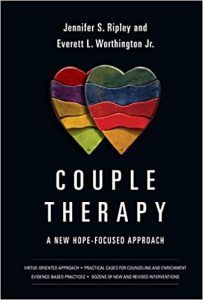
Couples Therapy outlines Ripley and Worthington, Jr.’s approach, expands on the theory behind it (note: approach also has a foundation in Christian beliefs), and provides assessment tools, real-life case studies, and resources for use in counseling.
You can find this book on Amazon, where it enjoys another rare achievement – a nearly perfect 5-star rating.
2. Couples Counseling: A Step by Step Guide For Therapists – Marina Williams
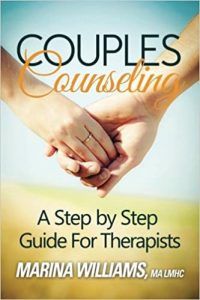
This book will walk the reader through a complete couples counseling treatment – from intake to termination.
With step-by-step instructions and evidence-based methods, tips, and exercises, this book can give a novice counselor the tools necessary to engage in their first clinical engagement.
This book is also very highly rated on Amazon, and you can read the reviews or purchase the book for yourself.
3. Clinical Handbook of Couple Therapy – Alan S. Gurman and Jay L. Lebow
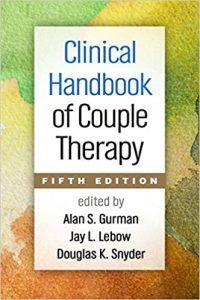
It covers the most popular and most effective methods and approaches in couple therapy, including the history, theoretical foundations, research findings, and techniques for each.
This updated text also includes information on applying these approaches to sensitive or complex contexts, such as blended families, LGBT couples, and separated couples.
It also aids the therapist in addressing clinical problems like partner aggression, psychological disorders, and medical issues. This newest edition of the Clinical Handbook of Couple Therapy can be purchased or reviewed on Amazon.
4. The High-Conflict Couple: A Dialectical Behavior Therapy Guide to Finding Peace, Intimacy, & Validation – Alan E. Fruzzette and Marsha M. Linehan
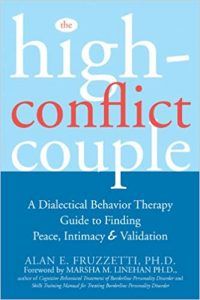
It is written specifically for couples who are highly reactive, or quick to argue, quick to anger, and quick to blame; however, any couple will find useful information in this book.
The High-Conflict Couple draws from Dialectical Behavior Therapy (DBT) to provide exercises, techniques, and tools that will help a couple improve their communication, rediscover trust, and address their problems in a healthy and productive manner.
You can find this book on Amazon.
5. Emotionally Focused Couple Therapy for Dummies – Brent Bradley and James Furrow
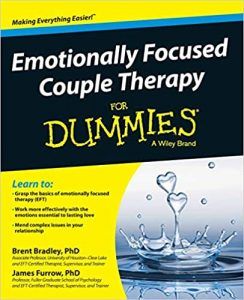
Whether you’re a student of couple or marriage therapy, a new practitioner, or simply someone who is interested in couple therapy, this book will be a valuable addition to your library.
Not only does it provide an overview of Emotionally-Focused Therapy, it also provides simple strategies, useful tips and tools, and interesting case studies to help you get the basics in this type of therapy.
You can find this highly reviewed “for Dummies” book on Amazon.
7 Couples Counseling Exercises, Worksheets, & Techniques
If you don’t have the time or the inclination to read through a book on couples therapy right now, that’s alright. There are some quicker and easier ways, also backed by couples counselors and therapists, to learn more about your partner and improve your connection.
A few of the most successful exercises, worksheets, and techniques are described next (Gray, 2014).
1. Soul Gazing
This is an intense exercise that will help you and your partner connect on a deeper level. It can have a huge impact on your sense of connectedness, but it’s not for the faint of heart!
To try this exercise, face your partner in a seated position. Move so close to one another that your knees are nearly touching, and look into each other’s eyes.
Hold eye contact for three to five minutes. Don’t worry, it’s not a competition – you can blink! However, refrain from talking. Simply look into one another’s eyes, even if it’s awkward at first. If the silence is uncomfortable, choose a song that is pleasant to both of you or meaningful in terms of your relationship and hold eye contact until the song ends (Gray, 2014).
Even popular culture has developed insight into the power of this exercise. Here’s one video below by Glamour that may make you cry—in a good way.
2. Extended Cuddle Time
This exercise is just as simple—and fun—as it sounds! The instructions are simply to cuddle more often.
It’s easy to get distracted with a cell phone, tablet, or book at bedtime, but cuddling is actually a much better way to end your day. The chemicals that are released when we cuddle with our partner improve our mood, deepen our connection, and can even help us sleep better.
This exercise is intended to be practiced right before bed, but you can carve out any time of the day to cuddle if bedtime doesn’t work for you. The important thing is to get some one-on-one time, show physical affection, and enhance your intimacy with your partner.
Relationship consultant Jordan Gray (2014) suggests cuddling to a music playlist if you have trouble finding or committing to a regular cuddle session. You could also sneak in some cuddle time while watching a movie or first thing in the morning when you both wake up – the point is to work it in however works best for you.
3. The 7 Breath-Forehead Connection Exercise
This exercise is an excellent way to take your mind off of what is happening around you and focus on your partner.
To begin, either lie down on your side by your partner or sit upright with your partner. Face each other and gently put your foreheads together. Make sure your chins are tilted down so you aren’t bumping noses and stay in this position for a few breaths.
Breathe at least seven slow, deep breaths in sync with your partner. It might be difficult at first, but you will get the hang of it before long. If you and your partner are enjoying the exercise, feel free to prolong it – take 20 breaths together, or 30, or simply breathe together for a set amount of time. There are no disadvantages to feel connected with your partner, so go for it!
This close breathing exercise will put you and your partner into an intimate, connected space. Practice it whenever you feel the need to slow down and refocus on each other.
4. Uninterrupted Listening
Another simple but powerful exercise is called Uninterrupted Listening, and it’s exactly what it sounds like (Gray, 2014). We all need to feel heard, understood, and cared for, and this exercise can help both you and your partner feel this way.
Set a timer for this exercise (three to five minutes will usually do the trick) and let your partner talk. They can talk about whatever is on their mind – work, school, you, the kids, friends or family, stress – it’s all fair game.
While they are speaking, your job is to do one thing and one thing only: to listen. Do not speak at all until the timer goes off. Simply listen to your partner and soak it all in. While you may not speak during this time, you are free to give your partner non-verbal encouragement or empathy through body language, facial expressions, or meaningful looks.
When the timer goes off, switch roles and try the exercise again. You may find that one partner is much chattier than the other, which is totally normal.
5. The Miracle Question
This exercise is a great way for couples to explore the type of future they would like to build, individually and as a couple. We all struggle at times, but sometimes the struggle is greater because we simply do not know what our goals actually are – asking the “Miracle Question” can help you or your clients to clarify your goals.
This question helps both partners to probe their own dreams and desires, and learn about their partner’s dreams and desires. It can aid a couple in understanding what both they and their significant other needs in order to be happy with the relationship.
Therapist Ryan Howes (2010) phrases the Miracle Question this way:
“Suppose tonight, while you slept, a miracle occurred. When you awake tomorrow, what would be some of the things you would notice that would tell you life had suddenly gotten better?”
While either partner may give an answer that is an impossibility in their waking life, their answer can still be useful. If practiced within the context of couples therapy, the therapist can dive deeper into the clients’ unrealistic miracle with this question: “How would that make a difference?”
This discussion helps the client(s) to envision a positive future in which their problems are addressed or mitigated, and the therapist to learn how he or she can best serve their clients in the session.
If you are engaging in this exercise without the guidance of a therapist, don’t try to dive too deep into the answer if it is unrealistic or impossible. Instead, use this discussion as an opportunity to learn something new about your partner and plan for your future together.
6. The Weekly CEO Meeting
If you and your partner are leading lives jam-packed with activities, events, and obligations, this exercise will be a great way to connect.
This exercise provides you and your partner with an opportunity to interact as adults (no kids allowed) and without distractions (no phones, tablets, or laptops allowed).
Schedule a non-negotiable chunk of time (30 minutes is a good default) once a week for you and your partner to talk about how you both are doing, your relationship as a couple, any unfinished arguments or grievances, or any needs that are not being met.
You can start the exercise with questions like:
- How do you feel about us today?
- Is there anything you feel incomplete about from this past week that you would like to talk about?
- How can I make you feel more loved in the coming days?
The answers to these questions should lead you and your partner in a healthy and productive discussion about your selves and your relationship. Make sure to do this regularly to keep on top of any issues and ensure that things don’t get swept under the rug or put on the back burner for too long (Gray, 2014).
7. Five Things… Go! Exercise
Another quick and easy exercise, this exercise can be engaged in anywhere the two of you are together. You only need your words and your imagination!
Come up with a theme for each time you practice this exercise – something like “what I’m grateful for,” “what I appreciate in you,” or “what I’d like to do with you this month” – and list five things each within this theme.
You could have one partner go first and list all five things, or you and your partner could alternate saying one of your five things at a time. However, you decide to do it, be creative and don’t be afraid to get silly with your partner!
As an example, you could ask your partner, “What are five things that you love that I have done for you lately?”
Their answers might be something like, “Taking out the trash, making a dinner reservation, getting my car detailed, cuddling with me, and watching my favorite movie with me.”
Once they finish their list, come up with your own answer to the question, such as, “Fixing the water heater, pulling weeds, sewing the button back on my shirt, telling me how much you love me, and kissing me goodnight each night.”
When you have both finished sharing your list, you can talk about your items, show each other appreciation, ask follow-up questions, or come up with more items together.
This exercise is a fun and engaging way to connect with your partner, learn something new, or reminisce over good shared memories.
Free Relationship Worksheets for Couples

A few of the best free worksheets that can help couples enhance their bond are listed and described below.
About Your Partner Worksheet
This worksheet is a great activity for those in a relationship who want to make changes or solve some difficult relationship problems. It keeps the discussion light but reminds a couple of their special connection, while helping them learn more about themselves and their partner.
The instructions direct the couple to take turns asking each other a question from each section below or ask them all if they believe they know the answers.
The questions are divided into six categories:
- Fun and Games (example question: What is your partner’s ideal vacation spot?)
- The Future (example question: What are the most important items on your partner’s bucket list?)
- You and Me (example question: What does your partner miss the most about you when you are apart?)
- Other People (example question: Is there anyone who your partner sees as a role model?)
- Careers (example question: What are your partner’s friends like in the office?)
- Feelings (example question: What are the main feelings your partner has experienced today?)
Asking and answering these questions can help couples feel closer, learn about each other, and reminisce or dream for the future together.
Use this About Your Partner Worksheet.
Good Qualities
This worksheet can help you or your client to remember the good qualities in your partner, especially when there are problems or arguments within the relationship.
Sometimes all it takes to get partners working together to solve their problems is a reminder of why they love each other.
The worksheet is divided into four sections to be filled out by the client:
- The good qualities which first drew me to my significant other were…
- The most cherished memories of our time together include…
- I appreciate my partner because…
- My partner shows me they care by…
For each section, the client is instructed to identify at least three things that they love about their partner, treasured memories with their partner, or the ways in which their partner returns their love.
Click to see this Good Qualities worksheet and print it out for yourself or your clients.
Appreciative Inquiry of Relationships
If you or your client are struggling in a romantic relationship, this is another good worksheet to try. When a couple is having trouble, it can sometimes help to dig deeper into the good stuff rather than on the problems they are experiencing.
Appreciative Inquiry (AI) examines what gives life to a relationship, through positive questions and respectful inquiry. A couple can use this approach to open up their past and look at their successes, potential, values, and strengths as a couple.
It will help the couple remember that they are a team with common goals, common desires, and common traits. There are five sections to fill out, with space below to record your answers:
- Identify an Important Relationship – This AI worksheet is ideal for deep diving into family relationships and friendships as well as for romantic partners. Try to be as descriptive as possible with your answers, looking at the current state of the relationship and your feelings toward your partner and things between you.
- Discover – This is divided into two steps.
- First, a Celebration exercise in which you will recall a shared experience that you would like to celebrate. What was worth celebrating about this experience or moment? What is it that made it so positive? What qualities did you bring to the moment? What about your partner?
- Next, a Maintenance activity in which you will reflect both on your own most positive contribution to sustaining the relationship, and your partner’s. What do you each bring to keep the relationship developing in a healthy way? What really works about that contribution?
- Dream – Your next step will be to envision your perfect future together. Take some time to close your eyes and visualize how you would like things to be? What are your aspirations and dreams for your future together? What words could your partner use to describe you that would make you feel proud? Use the space beneath this step to describe your dreams.
- Design – With your dream freshly written down, the following step is about designing concrete steps that you yourself could take toward that desired future. Think about your personal strengths and how those might help you in achieving your ideal relationship, then apply the same approach to the steps that you and your partner could take together.
- Destiny – Use this important final space to lay out your intentions so that you can commit to them. Consider the rationale for each intention you will commit to, as this will help motivate you when any potential obstacles arise. Try to make these “Whys” as meaningful as possible by linking them back to your personal values, as well as why the relationship itself is so important in your eyes.
Filling in these blanks will encourage a couple to remember the good things in their relationship and commit in a meaningful way to positive change that builds on their strengths.
In a world where busy days are followed by even busier days, reclaiming your control in the domains where you can is essential.
This is why we recommend building 5 Rituals of Connection with your partner.
Rituals in relationships are defined as meaningful actions repeated regularly by partners, with a specific emotional significance (Doherty, 2001). Rituals of connection can contribute to developing and maintaining positive and healthy relationships by reinforcing feelings of affection, comfort, and stability.
Consistently investing time into your relationships can contribute to long-lasting and meaningful patterns that facilitate loving and enduring connections. Finding this time in your busy day will never go unnoticed by your partner.

Apologizing Effectively
This is not technically a worksheet in the traditional sense, but it provides invaluable information about how to apologize effectively when either party has hurt their partner or damaged the trust in a relationship. For this reason, it is too great a resource not to share.
The four steps to effective apologizing are laid out as follows:
- Acknowledging – Whether you have hurt your partner willingly or unwillingly, you can begin an effective apology by taking responsibility and acknowledging the relevant offense. Demonstrate that you recognize your responsibility by “I” (“I messed up…” or “I am at fault…”). Acknowledge who has been hurt, as well as the nature of the transgression itself.
- Give an explanation for the offense – Explain both that you never meant to hurt the other person and that it won’t happen in the future. This worksheet also provides tips on how to distinguish between excuses and explanations for an effective, meaningful apology.
- Express your remorse – Naturally, we feel regret and remorse amongst other feelings when we hurt another person. Expressing the emotions that you feel – such as humiliation, shame, embarrassment, and so forth – can help your partner understand your recognition of the mistake. For example, “I feel really bad about what happened. For days I have felt embarrassed about how I let you down”.
- Make amends – Follow up your verbal acknowledgment and apology with actions that aim to fix the damage caused. Talk to your partner and see what they might consider a good reparation for the damage to your relationship.
This worksheet describes each step and provides tips for you or your client to follow the next time there is a disagreement, argument, or breach of trust.
To read more about these steps, you can access the worksheet via a subscription to our Positive Psychology Toolkit©.
Naikan Reflection
While the Naikan Reflection worksheet is something for each partner to work on alone, it’s still a great resource for couples who would like to build and maintain a healthy relationship.
The exercise, which can be accessed via our our Positive Psychology Toolkit©, encourages the reader to remember not to take his or her partner for granted.
It helps to cultivate feelings of appreciation and gratitude while encouraging each partner become more aware of where they stand morally with their partner. Following these suggestions can help couples show their partners appreciation and inject some gratitude into their relationship.
Naikan Reflection is a Japanese method of self-reflection that features in therapy as three questions (Krech, 2001); on this sheet there is space for you to record your answers. Thinking back over the past 24 hours, and with your partner specifically in mind, reflect on the following:
- What have I received? What support, care, and attention did you get from your partner? Did they say kind things to boost your self-confidence? Drive you to work or pick you up afterward? Was lunch packed for you? Feel free to list everything that you received from your partner over the past 24 hours.
- What have I given? Did you ask them how school was? Did you call them just to say hi? Pick up their clothes or rub their shoulders?
- What troubles or difficulties have I caused? Think now about the ways in which you might have caused any hassle or hurt for your partner throughout the day. Perhaps you snapped at them out of impatience, or pointed out something they forgot? Did you criticize some of their work, or forget to do something they were counting on?
One aim of this exercise is to cultivate your natural desire to help and care for your partner. By heightening your recognition of how much you really receive and offer in turn each day, Naikan Reflection is a useful exercise to boost your experience of gratitude and its benefits.
A Take-Home Message
This piece included a description of couples counseling or couples therapy and introduced several engaging, informative, and helpful exercises for making the most out of a romantic relationship.
We hope you found a few new ideas for how you can bond with your partner (or help your clients bond), but we also hope you got the underlying message—no relationship is perfect, but there are perfect ways of showing up for each other when it is hard.
No relationship is without an occasional problem, and even the best can benefit from some concerted effort on the part of each partner. Whether you are in a new relationship or going on your 50th anniversary, there is still more to learn about your partner and more new and interesting things to do together.
What do you think keeps your relationship happy and healthy? Have you tried any of these activities or exercises? What do you think is most important in a good romantic relationship? Let us know in the comments below.
Thanks for reading, and remember to appreciate your significant other. It will benefit both of you.
We hope you enjoyed reading this article. Don’t forget to download our three Positive Relationships Exercises for free.
- Bonior, A. (2017, September 19). Should you go to couples therapy? Psychology Today. Retrieved from https://www.psychologytoday.com/blog/friendship-20/201709/should-you-go-couples-therapy.
- Doherty, W. J. (2001). Take back your marriage: Sticking together in a world that pulls us apart. Guilford Press.
- Gray, J. (2014, November 18). 6 connection exercises for couples to build intimacy. Jordan Gray Consulting. Retrieved from https://www.jordangrayconsulting.com/2014/11/6-connection-exercises-for-couples-to-build-intimacy/
- Howes, R. (2010, January 18). Cool intervention #10: The miracle question. Psychology Today. Retrieved from https://www.psychologytoday.com/blog/in-therapy/201001/cool-intervention-10-the-miracle-question
- Krech, G. (2001). Naikan: Gratitude, grace, and the Japanese art of self-reflection. Berkeley, CA: Stone Bridge Press.
- Suval, L. (2015). Four fun bonding exercises for romantic relationships. Psych Central. Retrieved from https://psychcentral.com/blog/archives/2015/03/14/four-fun-bonding-exercises-for-romantic-relationships/
Let us know your thoughts
Read other articles by their category
- Body & Brain (49)
- Coaching & Application (57)
- Compassion (26)
- Counseling (51)
- Emotional Intelligence (24)
- Gratitude (18)
- Grief & Bereavement (21)
- Happiness & SWB (40)
- Meaning & Values (26)
- Meditation (20)
- Mindfulness (45)
- Motivation & Goals (45)
- Optimism & Mindset (34)
- Positive CBT (28)
- Positive Communication (20)
- Positive Education (47)
- Positive Emotions (32)
- Positive Leadership (18)
- Positive Parenting (4)
- Positive Psychology (33)
- Positive Workplace (37)
- Productivity (16)
- Relationships (46)
- Resilience & Coping (36)
- Self Awareness (21)
- Self Esteem (37)
- Strengths & Virtues (31)
- Stress & Burnout Prevention (34)
- Theory & Books (46)
- Therapy Exercises (37)
- Types of Therapy (64)
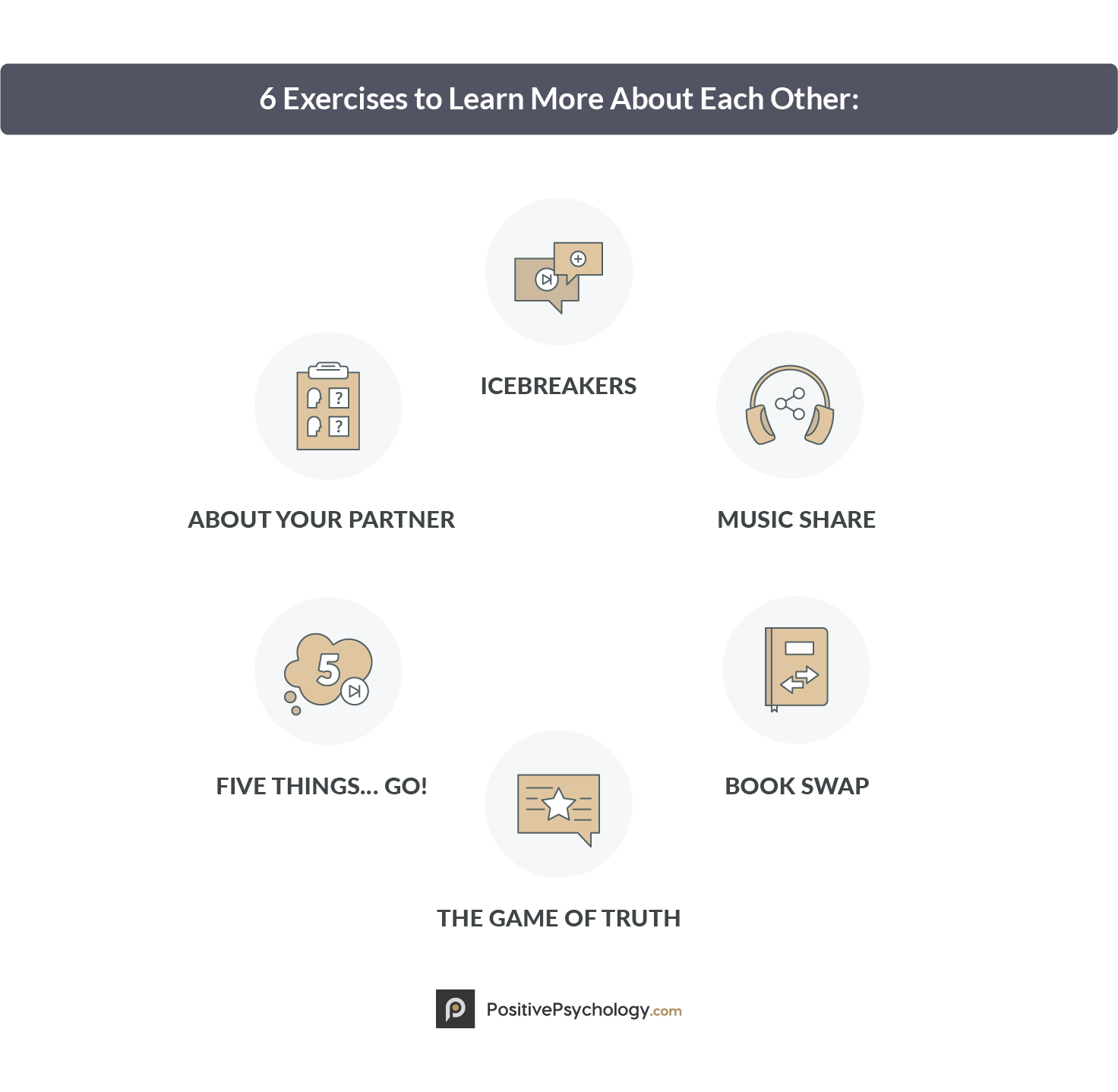

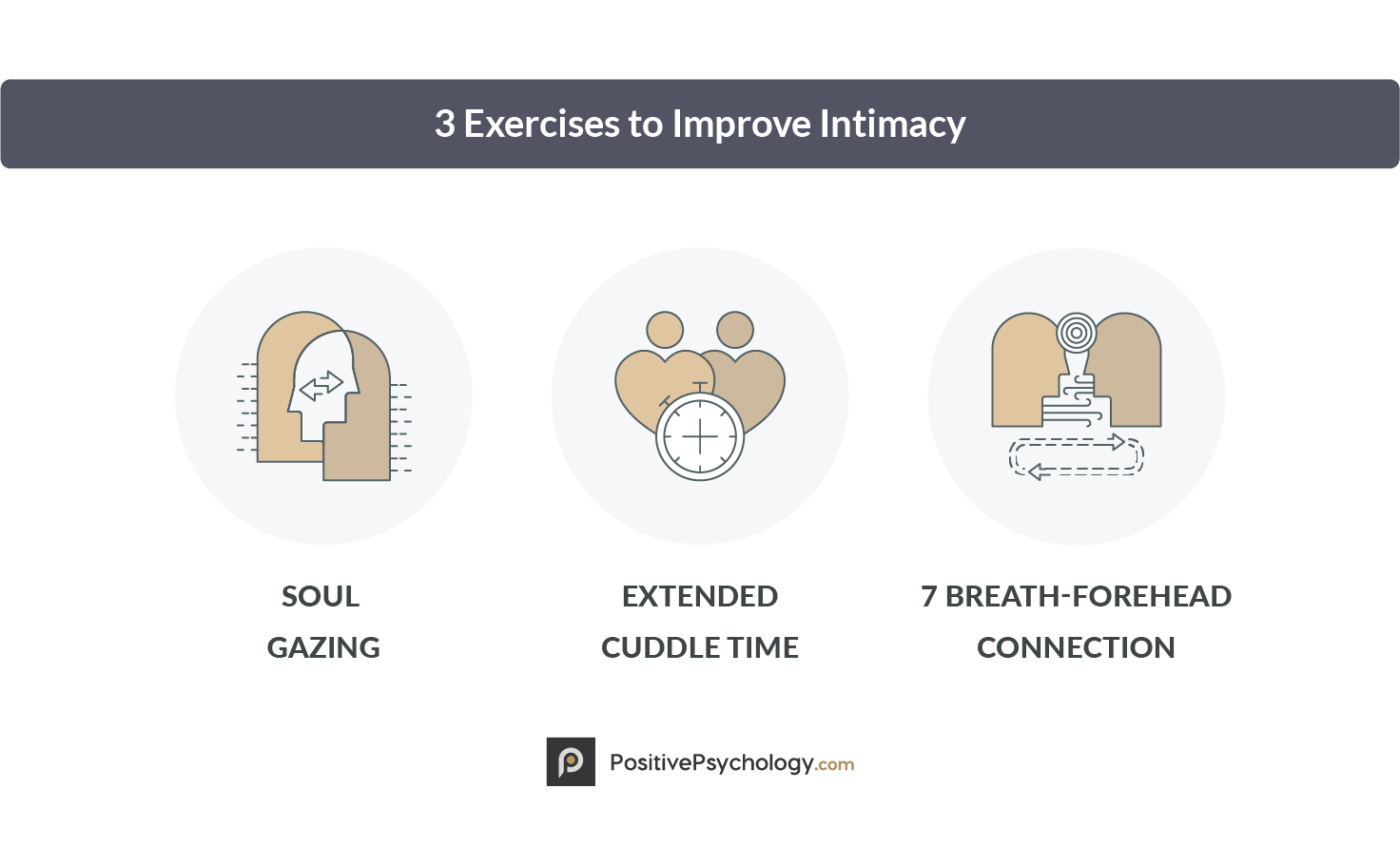
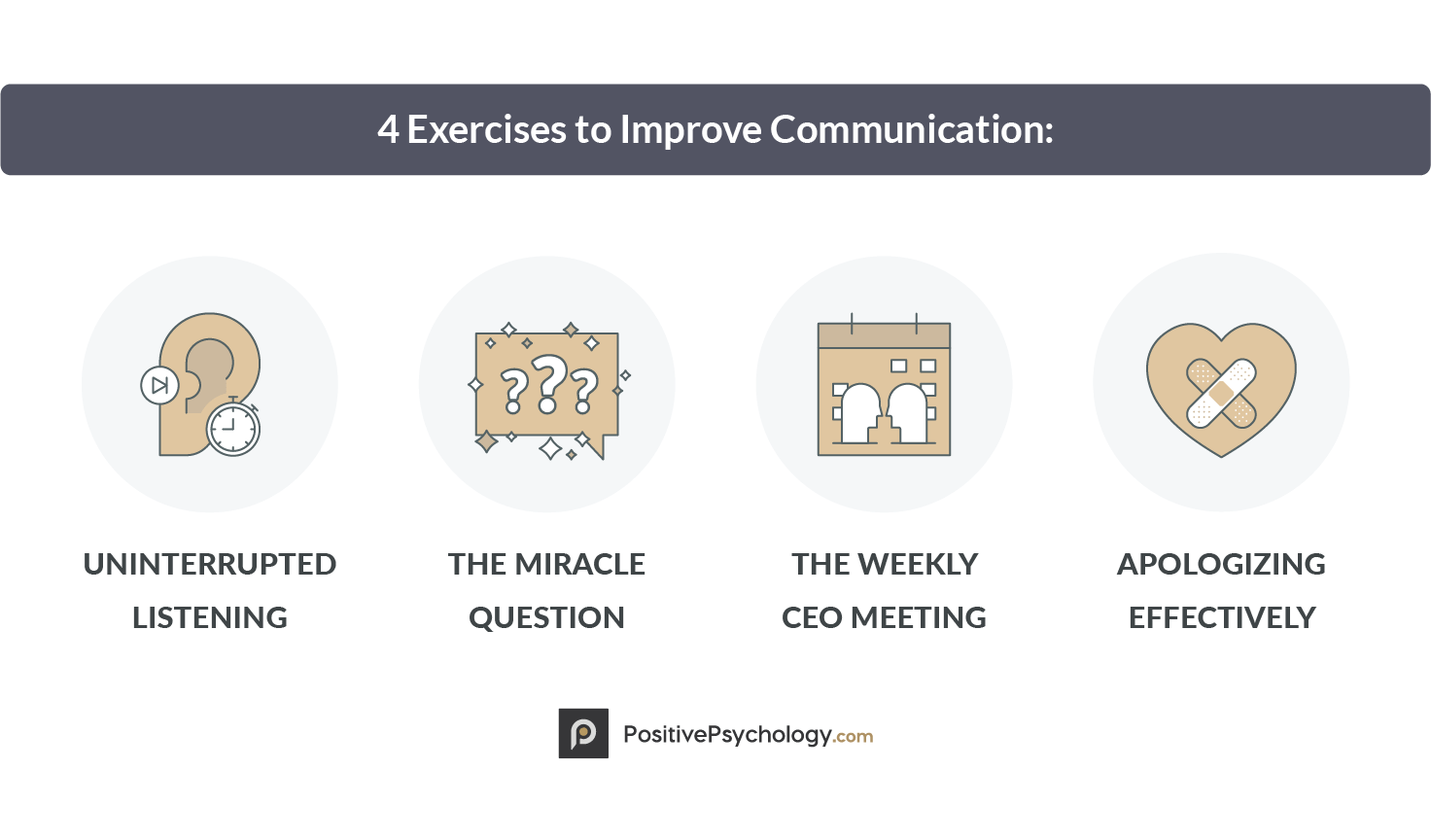
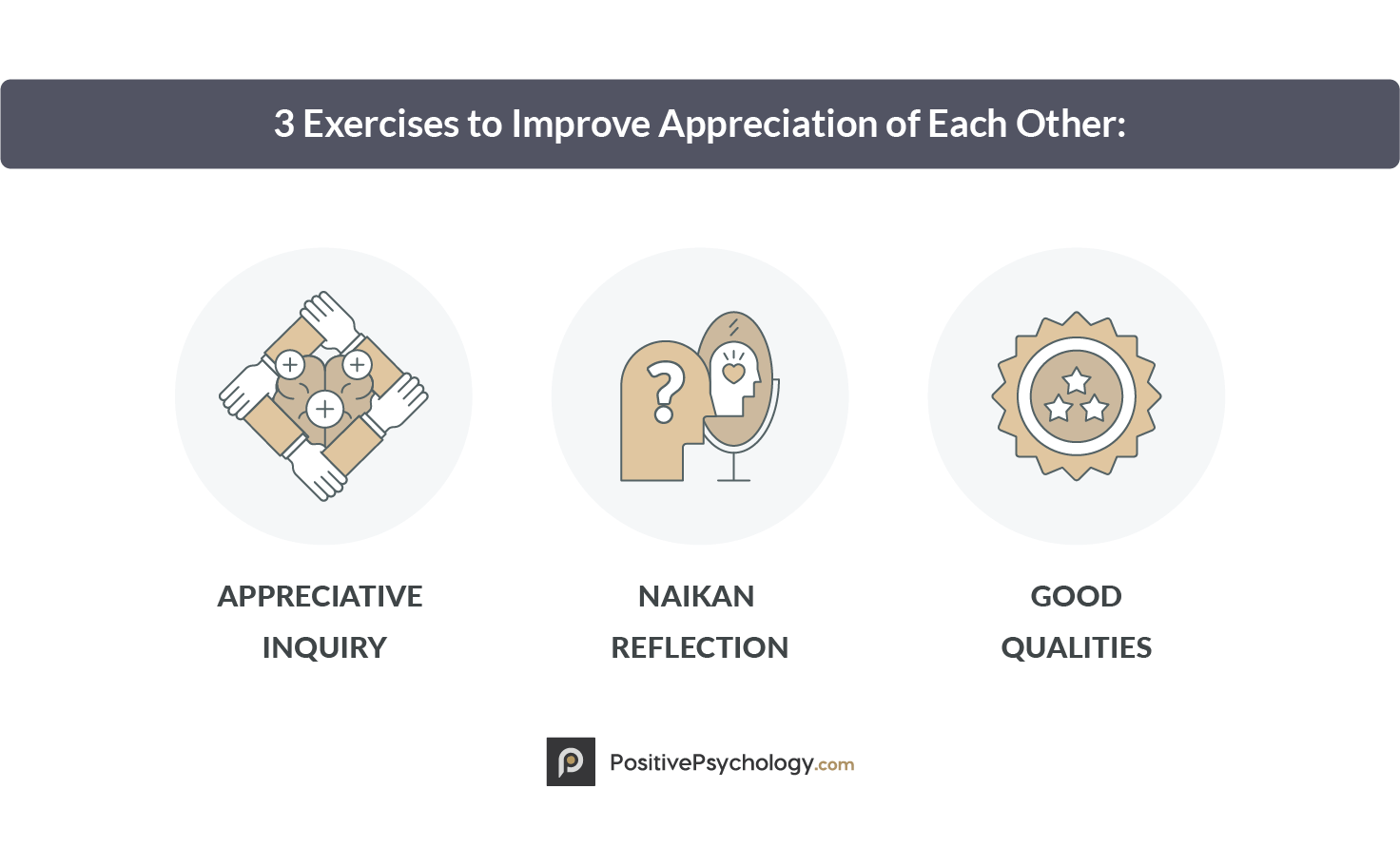




What our readers think
can anyone recommend some online resources (not in-person) for couples counseling? thank you
Hi Louise,
Here are some of our other relationship online resources:
(1) 21 Best Couples Counseling Exercises, Techniques, & Worksheets
(2) Marriage Counseling Toolkit: 30 Couples Therapy Worksheets
(3) Relationship Therapy Sessions: 45 Questions & Worksheets
I hope these are valuable to you!
Kind regards,
Julia | Community Manager
I WOULD LIKE TO GET MORE ARTICALS ON HOW TO BUILD A POSITIVE RELASTIONSHIP
Hi David,
Here is a list of articles that might be of interest to you:
– Attachment Styles in Relationships: 6 Worksheets for Adults
– How to Do Emotion-Focused Couples Therapy: 6 Interventions
– Building Healthy Relationships With 40 Helpful Worksheets
– The Importance of Forgiveness in Marriage and Relationships
I hope this helps!
Kind regards,
Julia | Community Manager
I have found “safe conversations” and also “conscious loving” approaches to be very helpful in my practice; also the 5 love languages.
a very timely readings
I am definitely going to try and do these things with my partner! 🙂
Any advice on low cost couples therapy in Portland OR!? Please! And thank you!
Hi Chloe,
You might want to take a look here to find affordable Couples Therapists in your area.
I hope this helps 🙂
Kind regards,
– Caroline | Community Manager
Thank you for this extensive write-up on couples therapy. I’m wondering what you think about the Gottman book for therapists about couples therapy, “10 Principles for Doing Effective Couples Therapy.”
Hi Shulamit,
I haven’t read this book personally, but we have recommended it elsewhere on our blog as an excellent resource (see here). Based on the Gottmans’ professional reputations and contributions to research and advances in couple’s therapy, I’m sure it’d be full of great advice 🙂
– Nicole | Community Manager